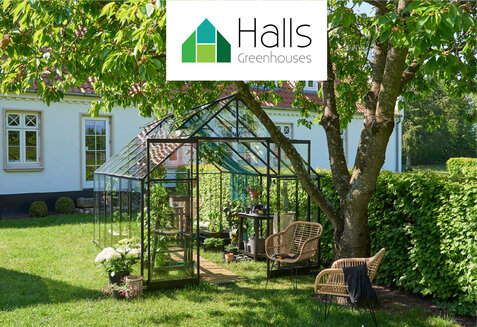Herbs in the Greenhouse
Greenhouse expert Christine Wiemann from Spirekassen guides to a good start with herbs in the greenhouse. She talks about which herbs can be grown in the greenhouse and when, and what the different herbs' needs are.

Spring has begun. The days are longer, and the greenhouse is warmer. Who does not dream of a corner in the greenhouse filled with herbs? There is a lot of great herbs. You probably have your personal favourites.
Here at Spirekassen, we often see some confusion regarding which herbs you can plant in the greenhouse and when. In this article, you can learn more about the difference of various groups of herbs.
Not everything is suited for the greenhouse
Most herbs don’t like being cultivated on a windowsill in the kitchen for a long period of time. Often, it is possible to purchase pots with herbs in the supermarket, that we often automatically place in the windowsill and water from time to time. ‘Supermarket herbs’ are grown in industrial greenhouses with artificial warmth and light. Supermarket herbs are only suited for a short life, after which they will die. The reason for the plants' short life span is a weak root net. The roots are not robust enough to survive outside of the protected world of industrial greenhouses.
In order to achieve success with herbs in the greenhouse, we must have knowledge of the different types. Every herb has specific cultivation demands.
The best way to achieve success with herbs in the greenhouse is to purchase adult plants from your local garden centre or grow the desired herbs from seed. The last is by far the cheapest.
A plant table is a good idea
If you don’t already have a plant table, it is a good idea to have one. We are very happy with this integral staging from Juliana in our Juliana Orangeri.
The staging is great to create a great corner with herbs in pots and at the same time for pre-germination of herbs from seeds.

Presprouting herbs

Rosmarry
Division of Herbs
Herbs can be divided into two groups. The heat demanding herbs and the less heat demanding herbs. In order for you to get an understanding of the cultivation needs of the herbs, you must look at where the herb is originally from; where it is native. The climate conditions, in its native area, should be replicated for the herb to be able to thrive.
Herbs that Can Withstand the Cold
This group of herbs can be described as either herbaceous perennial, subshrub or two-year plants. These herbs thrive for several years in a row:
Chervil
Mint
Oregano
Sage
Parsley
Leafed Parsley
Chives
Hyssop
Catnip
Hypericum
Camomile
Rosemarry
Lovage
Thyme
Caraway
Characteristics of This Group:
- All herbs in this group can be pre-germinated in the greenhouse in March.
- Start early with the pre-germination, as the seeds might take a while to germinate.
- This group of herbs can be cultivated in the greenhouse all year.
- It is a good idea to learn about the cultivation needs of every single herb.

Chervil in the greenhouse during winter

Leafed parsley in the greenhouse during winter
Heat Demanding Herbs
Some herbs are heat demanding because they originate from a warm climate. Below, you will find a group of herbs, that needs heat to germinate and thrive:
Coriander
Basil
Dill
Especially basil needs at least 15-20°C all day and night before the seeds will germinate and thrive. Coriander and basil are so heat demanding, that they thrive the best in the greenhouse. A less heat demanding herb is dill. Although dill will quickly evolve and form seeds in the heat of the greenhouse, dill can get too hot. At the same time it doesn’t like the cold.
Characteristics of This Group:
- All herbs in this group can pre-germinated in the greenhouse from May.
- The gemination happens quickly, usually after 1 to 2 weeks.
- This group of herbs cannot be cultivated in the greenhouse all year.
A Pesto Recipe
Ingredients:
Two handfuls of fresh basil
50 ml of olive oil
50 g of pine nuts
Parmesan cheese after taste
Add all the ingredients to a mini chopper and you will have pesto within two minutes. The pesto can last in the refrigerator for a couple of days. But no longer than that, as it has not added preservatives.
The Best Tip
There are of course a few months until you are able to grow basil in the greenhouse. Therefore, you can use ramson instead of basil, that can be harvested from March until June. Ramson grows wild in big parts of Europe. You can find ramson in forest areas with shade. Ramson contains a lot of good vitamin C and the taste and smell is similar to garlic. Ramson pesto tastes really delicious.

Pesto

Herbs in the greenhouse

Wild Garlic

JULIANA GROUP
Juliana Group er en førende global leverandør af kvalitetsdrivhuse til private. Virksomheden blev grundlagt i 1963 af Mogens A. Stærmose i Odense, Danmark. Den familieejede virksomhed ejes i dag af 3. generation, Nikolaj Stærmose. Hovedkontoret og fremstillingen er stadig beliggende i Odense med datterselskaber i Storbritannien og Tyskland. Juliana Group eksporterer til mere end 20 lande.
’We help people grow’. Derfor sætter vores brands Halls, Juliana og Gabriel Ash rammen for oplevelser, der er lige så naturlige, som de er magiske. Til trods for vores lange historie er vi fremadskuende og nysgerrige på, hvordan vi kan forbedre bæredygtigheden af vores drivhuse. Få mere at vide om Juliana her på siden og bliv en del af vores online fællesskab for alle drivhusentusiaster på Drivhusklubben.dk







